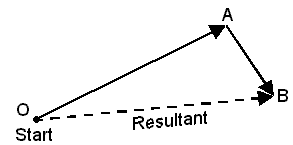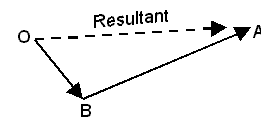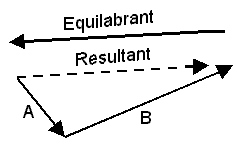Triangle of force
Two or more forces can be added or subtracted to produce a Resultant Force. If two forces are equal but act in opposite directions, then obviously they cancel each other out, and so the resultant is said to be zero. Two forces can be added or subtracted mathematically or graphically, and this procedure often produces a Triangle of Force.
Firstly, it is important to realise that a force has three important features; magnitude (size), direction and line of action.
Force is therefore a vector quantity, and as such, it can be represented by an arrow, drawn to a scale representing magnitude and direction.
Graphical Method

Consider two forces A and B. Choose a starting point O and draw OA to represent force A, in the direction of A. Then draw AB to represent force B.
The line OB represents the resultant of two forces.

Note that the line representing force B could have been drawn first, and force A drawn second; the resultant would have been the same.
Note how the two forces added together have formed 2 sides of the triangle; the resultant is the third side.

Also note that if a third force, equal in length but opposite in direction to the resultant is added to the resultant, it will cancel the effect of the two forces. This third force would be termed the Equilabrant.